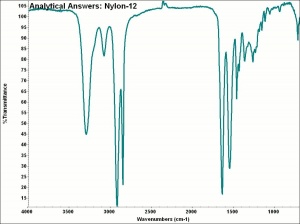Difference between revisions of "Nylon 12"
Jump to navigation
Jump to search
(username removed) |
|||
| (4 intermediate revisions by 3 users not shown) | |||
| Line 1: | Line 1: | ||
== Description == | == Description == | ||
| − | Nylon 12 is made by photonitrosation then polymerization of dodecalactam. Nylon 12 is similar in most properties to [ | + | Nylon 12 is made by photonitrosation then polymerization of dodecalactam. Nylon 12 is similar in most properties to [[nylon%2011|nylon 11]], but it has more stretch and resilience. Nylon 12 has low water absorption and good stability. It is used for packaging film, metal coatings, and injection molded plastics. |
| − | |||
| − | |||
| + | See also [[nylon%20fiber|nylon fiber]]. | ||
| + | [[[SliderGallery rightalign|aaiNYLON-12.jpg~FTIR]]] | ||
== Synonyms and Related Terms == | == Synonyms and Related Terms == | ||
| − | + | Rilsan® 12; polylaurylamide | |
| − | |||
| − | |||
| − | |||
| − | |||
| − | |||
| − | |||
| − | |||
| − | |||
| − | |||
| − | |||
| − | |||
| − | |||
| − | |||
| − | |||
| − | |||
| − | == | + | ==Physical and Chemical Properties== |
| − | + | * Burns with yellow-orange flame and blue smoke; smells of burnt horn. | |
| + | * Tenacity = 3.8 g/denier (dry or wet); | ||
| + | * Elongation = 40%; | ||
| + | * Moisture regain = 2.2% | ||
| + | * Melting Point = 180-190 C | ||
| + | * Density = 1.01-1.04 g/ml | ||
| − | == | + | ==Resources and Citations== |
| − | * | + | * G.S.Brady, ''Materials Handbook'', McGraw-Hill Book Co., New York, 1971 Comment: p. 553 |
| − | * | + | * Richard S. Lewis, ''Hawley's Condensed Chemical Dictionary'', Van Nostrand Reinhold, New York, 10th ed., 1993 |
| − | * | + | * Marjory L. Joseph, ''Introductory Textile Science'', Holt, Rinehart and Winston, Fort Worth, TX, 1986 |
| − | * | + | * J.Gordon Cook, ''Handbook of Textile Fibres:II Man-made Fibres'', Merrow Publishing Co. , Durham, England |
[[Category:Materials database]] | [[Category:Materials database]] | ||
Latest revision as of 12:54, 19 October 2022
Description
Nylon 12 is made by photonitrosation then polymerization of dodecalactam. Nylon 12 is similar in most properties to Nylon 11, but it has more stretch and resilience. Nylon 12 has low water absorption and good stability. It is used for packaging film, metal coatings, and injection molded plastics.
See also Nylon fiber.
Synonyms and Related Terms
Rilsan® 12; polylaurylamide
Physical and Chemical Properties
- Burns with yellow-orange flame and blue smoke; smells of burnt horn.
- Tenacity = 3.8 g/denier (dry or wet);
- Elongation = 40%;
- Moisture regain = 2.2%
- Melting Point = 180-190 C
- Density = 1.01-1.04 g/ml
Resources and Citations
- G.S.Brady, Materials Handbook, McGraw-Hill Book Co., New York, 1971 Comment: p. 553
- Richard S. Lewis, Hawley's Condensed Chemical Dictionary, Van Nostrand Reinhold, New York, 10th ed., 1993
- Marjory L. Joseph, Introductory Textile Science, Holt, Rinehart and Winston, Fort Worth, TX, 1986
- J.Gordon Cook, Handbook of Textile Fibres:II Man-made Fibres, Merrow Publishing Co. , Durham, England
